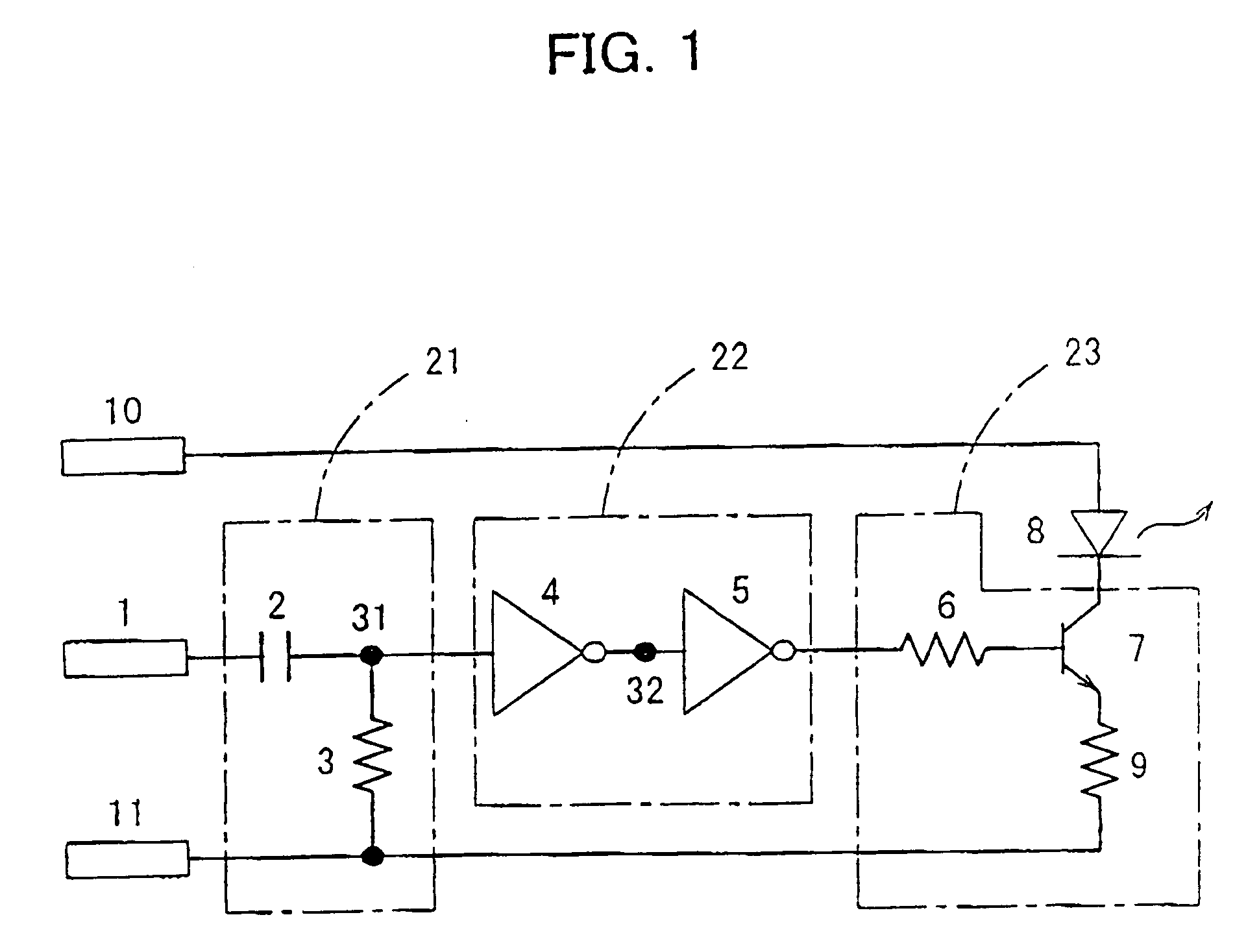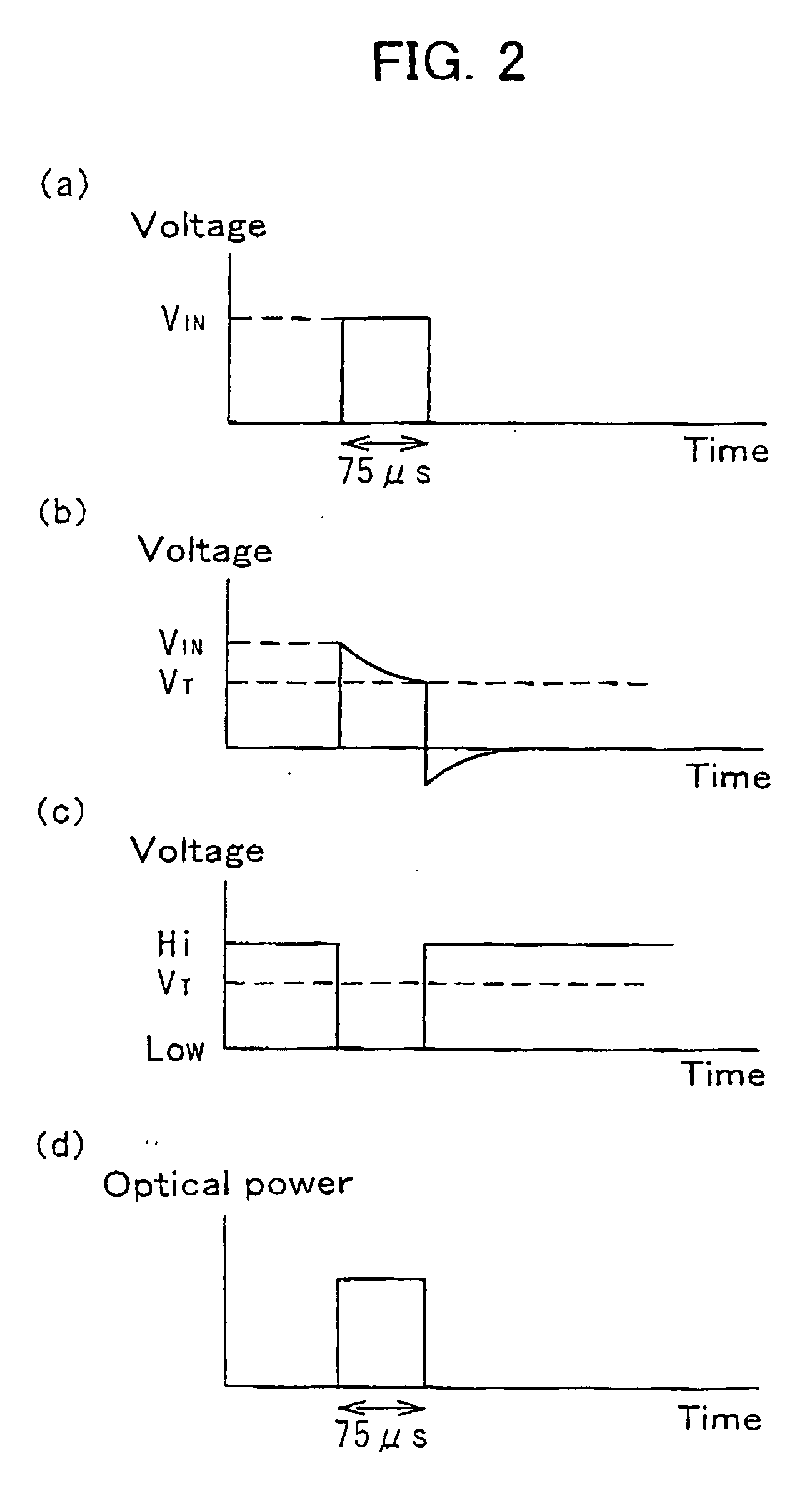Optical transmitter
a technology of optical transmitters and transmitters, applied in the field of infrared communication systems, can solve the problems of pdas and cellular phones, battery exhaustion and breakdown of light-emitting diodes, etc., and achieve the effect of preventing battery exhaustion and breakdown of light-emitting devices and low cos
- Summary
- Abstract
- Description
- Claims
- Application Information
AI Technical Summary
Benefits of technology
Problems solved by technology
Method used
Image
Examples
first embodiment
( Corresponding to Claims 1, 2, 3 and 5)
FIG. 1 is a circuit diagram showing the configuration of an optical transmitter in accordance with a first embodiment of the present invention. As shown in FIG. 1, this optical transmitter comprises a high-pass filter 21 for passing the high-frequency components of an optical transmission input signal having a rectangular pulse waveform, a binary circuit 22 for binarizing the output signal of the high-pass filter 21 so as to be returned to a pulse waveform, a light-emitting diode 8 serving as a light-emitting device for optical transmission, and a light-emitting device driving circuit 23 for driving the light-emitting diode 8 depending on the output signal of the binary circuit 22.
The high-pass filter 21 comprises an L-type circuit including a capacitor 2 and a resistor 3, for example.
The binary circuit 22 comprises two-stage inverters 4 and 5 connected in series, for example. The inverters 4 and 5 are each formed of a bipolar transistor, ...
second embodiment
( Corresponding to Claim 7)
FIG. 4 is a circuit diagram showing the configuration of an optical transmitter in accordance with a second embodiment of the present invention. As shown in FIG. 4, in this optical transmitter, the configuration of a light-emitting device driving circuit 24 differs from that of the light-emitting device driving circuit 23 shown in FIG. 1. In other words, in this light-emitting device driving circuit 24, an N-channel MOS transistor 12 is used instead of the NPN bipolar transistor 7. The other configurations are similar to those of the optical transmitter shown in FIG. 1.
In the circuit diagram of FIG. 1, the operating voltage of the optical transmitter is determined by the forward voltage of the light-emitting diode 8, the terminal voltage of the resistor 9 and the collector-emitter voltage of the NPN bipolar transistor 7.
Since the operating current of the light-emitting diode 8 is determined by light emission power, it is assumed herein that the current...
third embodiment
( Corresponding to Claim 6)
FIG. 5 is a circuit diagram showing the configuration of an optical transmitter in accordance with a third embodiment of the present invention. As shown in FIG. 5, in this optical transmitter, the configuration of a light-emitting device driving circuit 25 differs from that of the light-emitting device driving circuit 23 shown in FIG. 1. In other words, in this light-emitting device driving circuit 25, instead of the one-stage NPN bipolar transistor 7, a Darlington circuit having a two-stage configuration wherein NPN bipolar transistors 17 and 7 are connected in series is used. In this light-emitting device driving circuit 25, depending on the output signal of the binary circuit 22, input to the base of the first-stage NPN bipolar transistor 17, the next-stage NPN bipolar transistor 7 interrupts the current supplied to the light-emitting diode 8.
More specifically, the base of the first-stage NPN bipolar transistor 17 is connected to the other terminal of...
PUM
 Login to View More
Login to View More Abstract
Description
Claims
Application Information
 Login to View More
Login to View More - R&D
- Intellectual Property
- Life Sciences
- Materials
- Tech Scout
- Unparalleled Data Quality
- Higher Quality Content
- 60% Fewer Hallucinations
Browse by: Latest US Patents, China's latest patents, Technical Efficacy Thesaurus, Application Domain, Technology Topic, Popular Technical Reports.
© 2025 PatSnap. All rights reserved.Legal|Privacy policy|Modern Slavery Act Transparency Statement|Sitemap|About US| Contact US: help@patsnap.com



